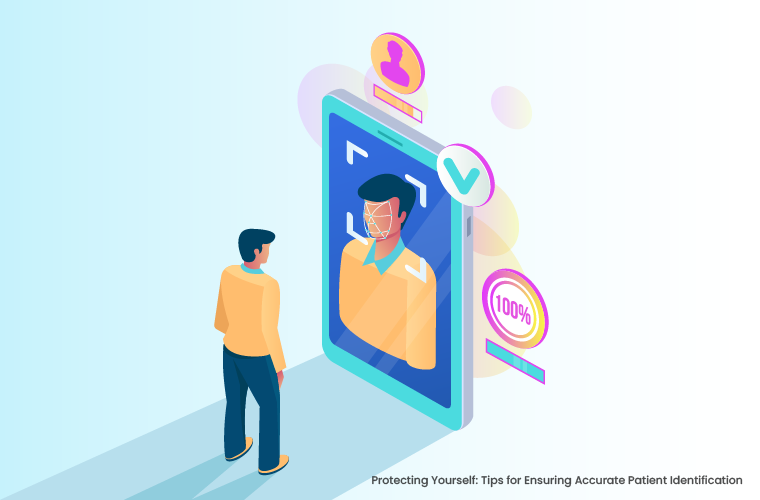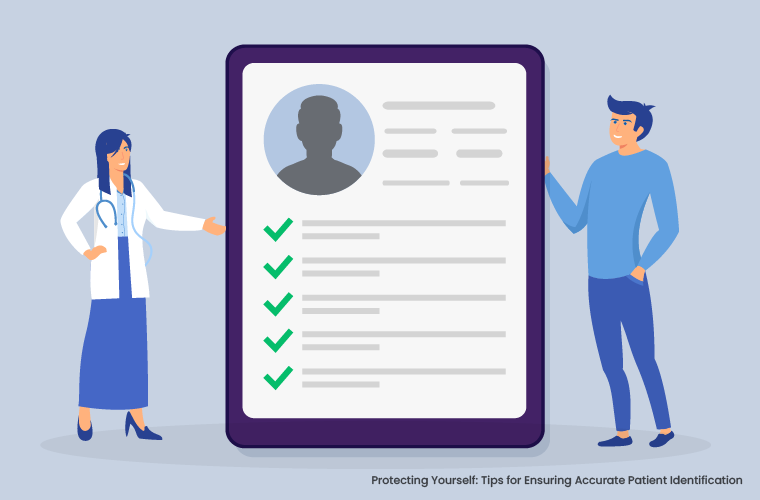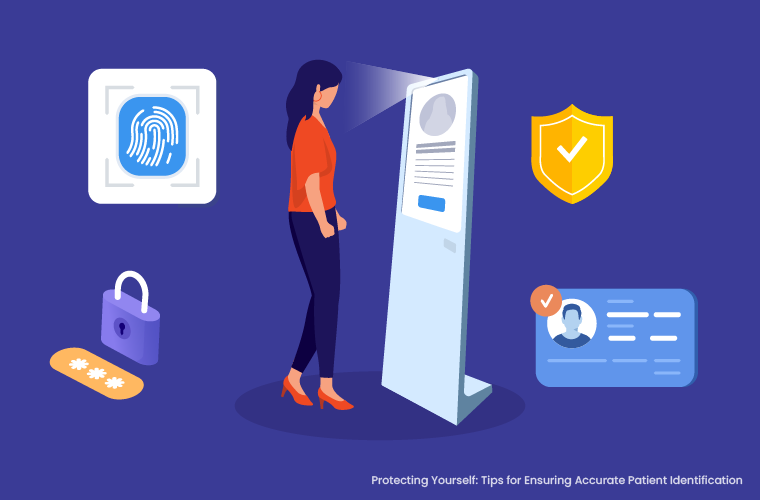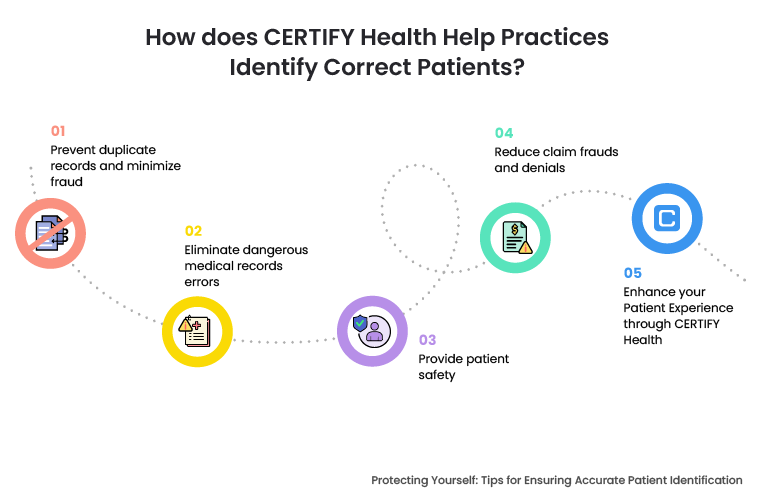According to a survey by The Ponemon Institute, patient misidentification leads to 30 minutes of wasted time/shift, and 35% of all claim denials overall. It also causes hospitals to lose $17.4 million per year in revenue.
It underscores how crucial is positive patient identification for healthcare practices in modern days. Inaccurate patient identification can result from even minor errors, like spelling mistakes in patient name or address or contact details.
These errors can have significant consequences for patients and providers – leading to increased anxiety and dissatisfaction among patients —and poor care outcomes, resulting in prolonged hospital stays or even fatalities.
This article is a comprehensive guide for healthcare providers, offering actionable tips to ensure accurate patient identification. Here you will explore strategies that enhance patient safety, reduce errors, and improve operational efficiency through precise identification.
We will also explore how to combat PPID errors by adopting robust solutions that focus on improving patient identification, ultimately enhancing patient safety and reducing costly errors.
Before discussing tips for ensuring accurate patient identification, let’s examine the growing challenges surrounding patient identity issues.

The Growing Challenge of Patient Identity Issues
Inaccurate patient identification has grown to be a major issue, threatening patient safety and costing practices a significant amount of money. These three striking figures demonstrate how vital it is to confront this escalating catastrophe.
High Rates of Misidentification
When matching the medical records of the patient, the accuracy rate can be as low as 80% within a single care setting and reduces to 50% among practices sharing electronic health information.
This percentage highlights the critical needs for accurate and consistent patient identification methods across all healthcare practices.
Financial Struggles with Patient Identity Issues
On average, healthcare practices spend $1.3M annually just for patient identity resolution. Furthermore, hospitals lose an average of $17.4 million per year due to denied insurance claims originating from inaccurate identification.
These costs clearly indicate the substantial financial burden that your practice might suffer due to patient identification errors.
Duplication of Medical Records
Manual patient identification is inefficient as it leads to entry of the patients’ record multiple times leading to duplication of medical records. This creates chaos for practices by complicating care coordination and risk in compromised care.
As per one report, some practices face duplicate record rates as high as 30%, which complicates patient care, increases staff workload, and raises maintenance costs. This underscores the need for improved patient identification systems to enhance operational efficiency and patient safety.
The consequences of Patient ID Errors
Unfortunately, patient identification errors continue to increase in healthcare, resulting in catastrophic errors. To understand the consequences, let us dive deeper into the real-world examples from ECRI database, that work to improve the safety and quality of healthcare.
- Two patients consulted for cataract surgery had the same first name. Inaccurate patient identification resulted in lens implant surgery done on the wrong patient.
- A patient admitted with cardiac arrest was not resuscitated because the practitioners referred the wrong patient’s record mentioned with “do-not-resuscitate” order.
- Patient identification error resulted in allergic medication given to the patient resulting in serious complication and fatal.
Do you believe now, how errors are so common in healthcare. A report from the Ponemon Institute clearly reveals that 86% of surveyed nurses and physicians have witnessed medical errors emerging from patient misidentification. These errors have a direct impact on both patient safety and the financial health of practices. These errors disrupt workflow efficiency and add to operational costs.
Misidentification also plays a significant role in denied claims as discussed earlier – 35% of all denied claims result from inaccurate patient identification, resulting in a revenue loss of $1.2 million per year. In addition, research from AHIMA found that 12% of EHRs contain duplicate records, which can lead to critical gaps in patient information along with chart correction.
To solve this problem, most practices are relying on PPID and let us see what PPID is below.
What is Positive Patient Identification?
What is PPID: A strong method for preventing patient misidentification is Positive Patient Identification (PPID), which makes use of biometric characteristics like fingerprints, palm prints, face features, and more. With the use of distinct patient identifiers, these biometric features guarantee accurate patient identification and the proper treatment of the appropriate patient.
This approach creates a secure and streamlined approach for patients to check-in, eliminating duplicate records while increasing data accuracy.
Now, let’s delve into some useful tips that can help healthcare providers in positive patient identification and improve overall safety through accurate patient identification.

Tips for Ensuring Accurate Patient Identification
Let us explore the tips to help you protect your patients and your healthcare organization from patient identification errors through precise patient identification.
Use Two or Multiple Identifiers
Ensuring accurate patient identification starts with the use of multiple identifiers. Healthcare providers should verify patient identity using at least two reliable identifiers, such as the patient’s full name, date of birth, or Social Security Number (SSN), before providing care or services. This step is essential to reduce the risk of duplicate records or cases of mistaken identity, which can lead to serious patient safety issues.
Did you know?
Inaccurate patient identification doesn’t just cause confusion—it opens the door to serious risks like misdiagnosis, billing errors, and even false claims.
A high malpractice claims rate often points to deeper issues in compliance and risk management, ultimately damaging patient trust, financial performance, and your organization’s reputation.
It’s also advisable to avoid using room numbers or bed locations as identifiers since these can frequently change, leading to potential confusion. By implementing this practice, healthcare settings can establish a consistent, robust approach to ensure positive patient identification and enhance overall patient safety.

Implement Biometric Identification Systems
In addition to using name, date of birth to identify patients, practices should use biometric technology like CERTIFY Health’s patient identification platform that offers fingerprint or facial recognition to accurately identify patients during check-in and throughout their care journey.
This approach ensures positive patient identification (PPID) and helps reduce risks associated with patient misidentification as discussed already. Incorporating biometric systems also allows for a faster, more secure check-in process, enhancing both operational efficiency and patient confidence by minimizing errors.
Standardize Registration Procedures
Standardized patient registration is vital for minimizing errors and maintaining high data accuracy. Ensure that patient registration forms are standardized and include mandatory fields to get important patient data for accurate data entry. With online registration forms, your healthcare setting can minimize the chances of getting human error to ensure that all critical information is captured.
Standardization also ensures that critical details are captured accurately, which is essential for proper billing, insurance processing, and continuity of care. A well-structured registration process creates a strong foundation for data accuracy and supports improved patient safety and administrative efficiency. To understand how we simplify patient registration procedures, you can visit our website.
Double-Check Patient Information
Before procedures or treatments, double-check patient information by confirming with the patient themselves or reviewing their records to verify that the data is accurate. The best way to double-check patient information is to involve patients throughout their care journey.
Ask patients to verify their identity prior to receiving medication or treatment and encourage them to engage actively throughout their care process. If possible, involve family members in verifying key identification details to ensure accuracy and enhance patient safety.
Leverage Patient Portals
Encourage patients to update their personal information through secure patient portals before appointments. To confirm your patient appointment and to secure your crucial patient information, your practice can leverage patient portals. It reduces discrepancies and ensures up-to-date data when they arrive at the practice, eliminating patient misidentification.
Cross-Check With Electronic Health Records (EHR)
Once a patient has registered their information, practices can synchronize it with Electronic Health Records (EHRs) for streamlined verification process. Before administration of any medical treatment on your patient, just cross-verify their details with details available on EHR and confirm their identify for accuracy and right treatment. This step helps catch any discrepancies early, minimizing the risk of inaccurate patient identification.
Use Unique Patient Identifiers (UPI)
Assigning each patient a unique identifier is essential for preventing identification errors and maintaining clear, accessible records. This identifier, often an alphanumeric code, is specifically linked to an individual patient and is designed to be unique across the system.
By assigning each patient an UPI, practices ensure that records are distinct, easy to locate, and reduce the risk of errors that arise from common names or similar demographic information. This approach also supports smoother communication between healthcare departments, as the unique patient identifier enables a more reliable tracking of patient records throughout their care journey.

CERTIFY Health - Leading the Way in Positive Patient Identification
CERTIFY Health is setting new standards in patient identification through integrating with biometric technology like facial recognition (FaceCheck), palm and fingerprint scanning. We help healthcare providers to ensure accurate, secure, and efficient patient matching across every stage of care.
This technology not only reduces the risks associated with patient misidentification but also enhances patient trust by safeguarding their data and ensuring that their medical history and records are correctly matched to them at every visit.
Eliminate duplicate records, reduce claim denials due to misidentification, and ultimately create a more positive, patient-centered experience with FaceCheck. As healthcare continues to prioritize accuracy, security, and patient satisfaction, CERTIFY Health remains a leader in providing cutting-edge solutions for accurate, secure patient identification.
Want to explore how CERTIFY Health can streamline your practice with advanced, secure patient identification solutions?
Visit our website to discover resources, articles, and tools designed to help you create a seamless, efficient, and patient-focused experience at every step.

















